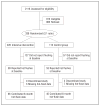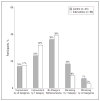An intensive behavioral weight loss intervention and hot flushes in women
- PMID: 20625026
- PMCID: PMC3030922
- DOI: 10.1001/archinternmed.2010.162
An intensive behavioral weight loss intervention and hot flushes in women
Erratum in
- Arch Intern Med. 2010 Sep 27;170(17):1601
Abstract
Background: Higher body mass index is associated with worse hot flushes during menopause but the effect of weight loss on flushing is unclear.
Methods: Self-administered questionnaires were used to assess bothersome hot flushes in a 6-month randomized controlled trial of an intensive behavioral weight loss program (intervention) vs a structured health education program (control) in 338 women who were overweight or obese and had urinary incontinence. Weight, body mass index, abdominal circumference, physical activity, calorie intake, blood pressure, and physical and mental functioning were assessed at baseline and at 6 months. Repeated-measures proportional odds models examined intervention effects on bothersome hot flushes and potential mediating factors.
Results: Approximately half of participants (n = 154) were at least slightly bothered by hot flushes at baseline. Among these women, the intervention was associated with greater improvement in bothersome flushes vs control (odds ratio [OR] for improvement by 1 Likert category, 2.25; 95% confidence interval [CI], 1.20-4.21). Reductions in weight (OR, 1.32; 95% CI, 1.08-1.61; per 5-kg decrease), body mass index (1.17; 1.05-1.30; per 1-point decrease), and abdominal circumference (1.32; 1.07-1.64; per 5-cm decrease) were each associated with improvement in flushing, but changes in physical activity, calorie intake, blood pressure, and physical and mental functioning were not related. The effect of the intervention on flushing was modestly diminished after adjustment for multiple potential mediators (OR, 1.92; 95% CI, 0.95-3.89).
Conclusion: Among women who were overweight or obese and had bothersome hot flushes, an intensive behavioral weight loss intervention resulted in improvement in flushing relative to control. Trial Registration clinicaltrials.gov Identifier: NCT00091988.
Figures


References
-
- Stearns V, Ullmer L, López JF, Smith Y, Isaacs C, Hayes D. Hot flushes. Lancet. 2002;360(9348):1851–1861. - PubMed
-
- Freeman EW, Sammel MD, Liu L, Gracia CR, Nelson DB, Hollander L. Hormones and menopausal status as predictors of depression in women in transition to menopause. Arch Gen Psychiatry. 2004;61(1):62–70. - PubMed
-
- Freedman RR, Krell W. Reduced thermoregulatory null zone in postmenopausal women with hot flashes. Am J Obstet Gynecol. 1999;181(1):66–70. - PubMed
-
- Rossouw JE, Prentice RL, Manson JE, et al. Postmenopausal hormone therapy and risk of cardiovascular disease by age and years since menopause. JAMA. 2007;297(13):1465–1477. - PubMed
Publication types
MeSH terms
Associated data
Grants and funding
LinkOut - more resources
Full Text Sources
Other Literature Sources
Medical

